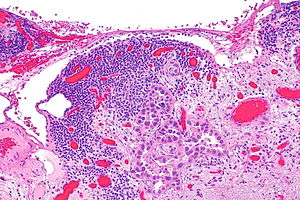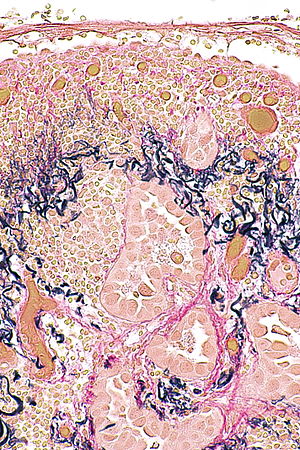Pleural invasion
Jump to navigation
Jump to search




Visceral pleural invasion. H&E stain. (WC)
Pleural invasion is the presence of tumour in the pleura. Pleural invasion is considered a poor prognosticator in lung cancer,[1][2] and important in determining the tumour stage in lung cancer staging.
General

Normal visceral pleura of the lung. Miller stain. (WC)
The visceral pleura is the pleura that covers the lung; tumour invasion into it is known as visceral pleural invasion (abbreviated VPI). The parietal pleural covers the chest wall.
The visceral pleura has two elastic layers:[3]
- External elastic layer.
- Usually thick/prominent.
- Important for staging.
- Internal elastic layer.
- Thin - may be difficult to see.
- Irrelevant for staging.
Images - normal pleural
Modified Hammar classification
Pleural invasion can be subgrouped as follows:[1]
| Category | Description | Tumour stage (TNM staging) |
|---|---|---|
| PL0 † | tumour confined to lung, not through elastic layer | T(any) |
| PL1 † | tumour beyond (external) elastic layer of the visercal pleura, not at pleural surface | at least T2 ‡ |
| PL2 | tumour at surface of pleura, not in parietal pleura | at least T2 |
| PL3 | tumour within parietal pleura and visceral pleura | at least T3 |
Notes:
- † The interface between PL0 and PL1 is the most challenging. Use of an elastic stain is recommend when there is uncertainty.[3]
- ‡ The up-staging of small tumours is not completely without controversy; there is data for lung adenocarcinomas less than 2 cm that suggests VPI is not an outcome predictor.[4]
Gross
- Tumour close to visceral pleura, e.g. <1 mm - high probability of VPI.
- Puckering of the visceral pleura overlying the tumour - suspicious for VPI.
Microscopic
Features - for PL1:
- Must be through the external elastic layer.[3]
Note:
- Tumour trapped within the (external) elastic layer is still PL0.[3]
Images
Stains

Visceral pleural invasion. Miller stain. (WC)
- Elastic stain (e.g. Miller, elastic trichrome, Verhoeff-van Gieson) - demonstrating tumour superficial to the (external) elastica.
Images
See also
References
- ↑ 1.0 1.1 Travis, WD.; Brambilla, E.; Rami-Porta, R.; Vallières, E.; Tsuboi, M.; Rusch, V.; Goldstraw, P. (Dec 2008). "Visceral pleural invasion: pathologic criteria and use of elastic stains: proposal for the 7th edition of the TNM classification for lung cancer.". J Thorac Oncol 3 (12): 1384-90. doi:10.1097/JTO.0b013e31818e0d9f. PMID 19057261.
- ↑ Shimizu, K.; Yoshida, J.; Nagai, K.; Nishimura, M.; Ishii, G.; Morishita, Y.; Nishiwaki, Y. (Jul 2005). "Visceral pleural invasion is an invasive and aggressive indicator of non-small cell lung cancer.". J Thorac Cardiovasc Surg 130 (1): 160-5. doi:10.1016/j.jtcvs.2004.11.021. PMID 15999057.
- ↑ 3.0 3.1 3.2 3.3 Dacic, S. (Oct 2012). "Dilemmas in lung cancer staging.". Arch Pathol Lab Med 136 (10): 1194-7. doi:10.5858/arpa.2012-0282-CC. PMID 23020722.
- ↑ Nitadori, J.; Colovos, C.; Kadota, K.; Sima, CS.; Sarkaria, IS.; Rizk, NP.; Rusch, VW.; Travis, WD. et al. (Nov 2013). "Visceral pleural invasion does not affect recurrence or overall survival among patients with lung adenocarcinoma ≤ 2 cm: a proposal to reclassify T1 lung adenocarcinoma.". Chest 144 (5): 1622-31. doi:10.1378/chest.13-0394. PMID 23807749.












